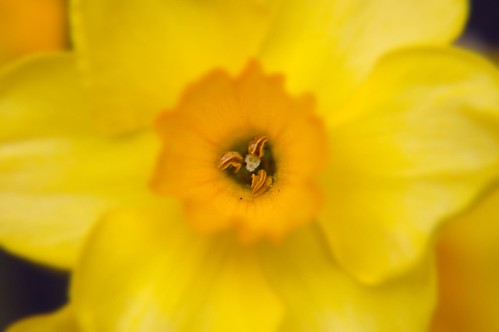Daffodils are harbingers of spring, so it’s a pleasure to photograph these beautiful flowers. However, I think these are hard flowers to portray in an original way.
About this photo I was asked, “Did you use your Lensbaby?” (Click here for some of my Lensbaby photos.)
A very reasonable guess, because the photo appears to have a “sweet spot” that is in focus in the center of the daffodil. But in fact, this photo started life as a fairly conventional macro. The daffodil was blowing around in the breeze (as they are wont to do), so I photographed it handheld with a vibration reduction lens, 36mm extender, and a +4 diopter close-up lens. The exposure at 1/60 of a second and f/5.6 was more or less fast enough to stop the motion of the flower, but didn’t give me enough depth of field to keep the detail in the center (which is really incredibly small) and on the petals (on the plane behind) both in focus. When I looked at the photo in Adobe Bridge, I liked this unusally close portrait of the daffodil but was uneasy about the not-quite-sharp aspect of the flower background.
I decided that the way to go was to accentuate the effect. In Photoshop, I selected the entire photo, and then used the Lasso selection tool in negative mode to deselect the center of the flower. I then added a great deal of Gaussian blur to the background. Next, I inverted the selection, and used Smart Sharpen to get the center detail of the flower really crisp.
Manipulation? Sure. But I like the result. Like the Lensbaby, post-production manipulation in Photoshop is a tool in your quiver when you shoot macros of flowers (or any other digital photo).
